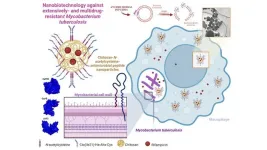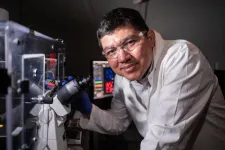(Press-News.org) Toxic chemicals produced from oil emissions and wildfire smoke have been found in muscle and liver samples from Southern Resident killer whales and Bigg’s killer whales.
A study published today in Scientific Reports is the first to find polycyclic aromatic hydrocarbons (PAHs) in orcas off the coast of B.C., as well as in utero transfer of the chemicals from mother to fetus.
“Killer whales are iconic in the Pacific Northwest—important culturally, economically, ecologically and more. Because they are able to metabolically process PAHs, these are most likely recent exposures. Orcas are our canary in the coal mine for oceans, telling us how healthy our waters are,” said senior author Dr. Juan José Alava, principal investigator of the UBC Ocean Pollution Research Unit and adjunct professor at Simon Fraser University.
PAHs are a type of chemical found in coal, oil and gasoline which research suggests are carcinogenic, mutagenic, and have toxic effects on mammals. Their presence in the ocean comes from several sources, including oil spills, burning coal and forest fire smoke particles.
Researchers analyzed muscle and liver samples from six Bigg’s, or transient, killer whales and six Southern Resident killer whales (SRKWs) stranded in the northeastern Pacific Ocean between 2006 and 2018. They tested for 76 PAHs and found some in all samples, with half the PAHs appearing in at least 50 per cent of the samples. One compound, a PAH derivative called C3-phenanthrenes/anthracenes, accounted for 33 per cent of total contamination across all samples. These forms of PAHs, known as alkylated PAHs, are known to be more persistent, toxic, and to accumulate more in the bodies of organisms or animals than parental PAHs.
No one has studied PAHs in killer whales in B.C. before. However, the researchers noted the average level of contamination in their study was lower than previous studies of cetaceans in the Gulf of California, and almost two times higher than that found in blood samples of captive killer whales from Icelandic waters.
SRKW contaminants largely from human emissions
The contaminants in Bigg’s killer whales were mostly those produced by burning coal and vegetation, as well as forest fires. In SRKWs, they were the kind produced by oil spills and burning of fossil fuels like gasoline. The researchers say this could be due to the animals’ differing habitats. Bigg’s killer whales range from California to southeastern Alaska and into the North Pacific Ocean, while SRKWs stay closer to more polluted urban environments around the Salish Sea.
Feeding preferences, behaviour and metabolism could also impact the amount of contaminants accumulating in the animals.
“B.C.’s coast is experiencing oil pipeline developments, oil tanker traffic, industrial effluents, forest fires, stormwater runoff and wastewater,” said first author Kiah Lee, who conducted the work as an undergraduate student at UBC’s Institute for the Oceans and Fisheries (IOF) and is now a masters student at the University of Oslo. “These activities put toxic PAHs into the marine food web and, as we saw here, they can be found in orcas, the apex predator.”
Improve pollution management
“There’s only a small population to draw from—74 individuals in the case of the Southern Residents,” said co-author Dr. Stephen Raverty, IOF adjunct professor and veterinary pathologist with the B.C. Ministry of Agriculture and Food. “There are many potential causes for their decline, pollution being one.”
One of the whales examined was ‘Luna’, an orca separated from his mother as a calf who had extensive human contact and lived in variable habitats, which may be why Luna showed a mixture of hydrocarbon contaminants.
“The preliminary findings from this study will add key information to inform management approaches in killer whale habitats,” said Paul Cottrell of Fisheries and Oceans Canada. “The source of the PAHs is often from human activity and it is important we have baseline data on current PAH levels in killer whales to monitor those trends and impacts in marine ecosystems into the future.”
Ultimately, humans need to reduce and eventually eliminate fossil fuel consumption to help combat climate change and conserve marine biodiversity, said Dr. Alava. “This would also serve to bolster the resilience and health of marine ecosystems, benefiting communities that rely on them such as coastal First Nations peoples as well as future generations.”
END
Toxic chemicals found in oil spills and wildfire smoke detected in killer whales
2023-12-19
ELSE PRESS RELEASES FROM THIS DATE:
Schar school researchers to receive funding for nonprofit employment data project
2023-12-19
Schar School Researchers To Receive Funding For Nonprofit Employment Data Project
Alan Abramson, Professor, Government and Politics; Mirae Kim, Associate Professor, Nonprofit Studies; and Stefan Toepler, Professor, Nonprofit Studies, are set to receive funding for: "Nonprofit Employment Data Project."
The researchers will produce a comprehensive report on nonprofit employment in the United States, based on new data that is expected to be released by the U.S. Bureau of Labor Statistics (BLS) early in 2024. The researchers will also arrange for the transfer of the Nonprofit Works interactive database application, which is currently hosted by Johns ...
Nanoparticles with antibacterial action shorten duration of tuberculosis treatment
2023-12-19
A low-cost technology involving nanoparticles loaded with antibiotics and other antimicrobial compounds that can be used in multiple attacks on infections by the bacterium responsible for most cases of tuberculosis has been developed by researchers at São Paulo State University (UNESP) in Brazil and is reported in an article published in the journal Carbohydrate Polymers. Results of in vitro tests suggest it could be the basis for a treatment strategy to combat multidrug bacterial resistance.
According ...
Marzougui & Kan developing crashworthy tangent end treatment for low-speed & curbed roadways
2023-12-19
Marzougui & Kan Developing Crashworthy Tangent End Treatment For Low-Speed & Curbed Roadways
Dhafer Marzougui, Associate Professor, Physics and Astronomy, and Cing-Dao Kan, Professor/Director, Center for Collision Safety and Analysis, received $749,954 from the National Cooperative Highway Research Program for: "Development of a Crashworthy Tangent End Treatment for Low-Speed and Curbed Roadways."
This funding began in Nov. 2023 and will end in Nov. 2026.
###
About George Mason University
George Mason University is Virginia's largest public research university. ...
A malaria drug treatment could save babies’ lives
2023-12-19
Wars, drought, displacement, and instability are causing a dramatic increase in the number of pregnant and breastfeeding women around the world who suffer from malnutrition. Without access to sufficient nutrients in the womb, babies born to these women are more likely to die due to complications like pre-term birth, low birth weight, and susceptibility to diseases like malaria. To try to reduce the risk of malarial infection, the WHO recommends that pregnant women in low-income countries be treated with a combination of the antimalarial drugs sulfadoxine and pyrimethamine ...
Engineered human heart tissue shows Stanford Medicine researchers the mechanics of tachycardia
2023-12-19
Heart rates are easier to monitor today than ever before. Thanks to smartwatches that can sense a pulse, all it takes is a quick flip of the wrist to check your heart. But monitoring the cells responsible for heart rate is much more challenging — and it’s encouraged researchers to invent new ways to analyze them.
Joseph Wu, M.D., Ph.D., director of the Stanford Cardiovascular Institute and professor of medicine and of radiology, has devised a new stem cell-derived model of heart tissue ...
Molecular jackhammers’ ‘good vibrations’ eradicate cancer cells
2023-12-19
The Beach Boys’ iconic hit single “Good Vibrations” takes on a whole new layer of meaning thanks to a recent discovery by Rice University scientists and collaborators, who have uncovered a way to destroy cancer cells by using the ability of some molecules to vibrate strongly when stimulated by light.
The researchers found that the atoms of a small dye molecule used for medical imaging can vibrate in unison ⎯ forming what is known as a plasmon ⎯ when stimulated by near-infrared light, causing the cell membrane of cancerous cells to rupture. ...
Nearly 30% of caregivers for severe stroke survivors experience psychological distress
2023-12-19
Stroke is an abrupt, devastating disease that instantly changes a person’s life and has the potentially to cause lasting disability or death. However, the condition also has profound effects on the patient’s loved ones — who are often called to make difficult decisions quickly.
A new study led by Michigan Medicine finds that nearly 30% of caregivers of severe stroke patients experience high levels of anxiety, depression or post-traumatic stress during the first year after the patient leaves the hospital.
The results are published in Neurology.
“As physicians, we usually concentrate on our ...
MSU research suggests pandas are active posters on ‘social media’
2023-12-19
MSU has a satellite uplink/LTN TV studio and Comrex line for radio interviews upon request.
Images
Pandas, long portrayed as solitary creatures, do hang with family and friends — and they’re big users of “social media.” Scent-marking trees serve as a panda version of Facebook.
An article in the international journal Ursus paints a new lifestyle picture of the beloved bears in China’s Wolong National Nature Reserve, a life that’s shielded from human eyes because they’re shy, rare and live in densely forested, remote areas. No one really knows how pandas hang, but a new study indicates pandas are around others more than previously thought. ...
UTHSC, Vanderbilt University receive $2.4 million grant to promote diversity in speech-language pathologists for high-need children
2023-12-19
The Department of Audiology and Speech Pathology at the University of Tennessee Health Science Center and the Department of Hearing and Speech Sciences at Vanderbilt University have secured a $2,399,454 grant to fund a five-year project to address the need for diversity in highly trained professionals in speech-language pathology.
The project, known as Project PAL (Preparing Academic Leaders in Speech-Language Pathology to Teach, Conduct Research, and Engage in Professional Service to Improve Outcomes for Children with High Need Communication Disorders), ...
American University receives $5.7 million from NSF to bridge research and policy, address real-world challenges
2023-12-19
American University won a $5.7 million cooperative research agreement from the U.S. National Science Foundation’s Accelerating Research Translation program. The award will help AU foster greater use of evidence in the public and private sectors by producing new knowledge on best practices in research translation, training scholars in the effective conduct of research translation, and supporting the dissemination of research findings that have the potential to benefit society.
The ART program ...


